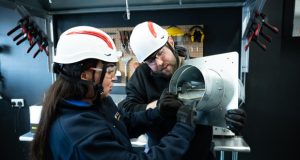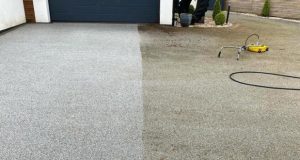As children up and down the country start a new school year, it’s always a busy time for parents or guardians. From sorting new school uniforms, to finding the ‘coolest’ stationery, this time of year can be stressful. One thing that may not be top of mind is the level of bacteria children may be exposed to in the playground or classroom. In this piece, we will explore the unexpected germ hotspots in schools, how parents can best equip their children with tips on hand hygiene, as well as what facility managers and school cleaners need to bear in mind for the new school term.
What does the environment look like?
When you consider the number of touch points in a school that could potentially transfer bacteria and germs between school children and teachers, you start to appreciate the importance of ensuring a proper cleaning regime is in place. Across the classroom, toilets, corridors and outside play areas, there are a number of surfaces that are likely to harbour bacteria. But how can you tell which ones pose the highest risk to contaminating an individual?
After undertaking an extensive swabbing exercise of 130 touchpoints within both an infant school and a junior school surprisingly, we found a pen pot, which delivered a bacterial reading almost 10 times higher than the average readings that we recorded on the toilet door handles.
This exercise demonstrates that even with a thorough and proactive cleaning regime in place, it is easy to miss an area of high microbial activity, which is very often in places you would least expect. While a surface may look clean, it could be covered in pathogens which can increase the chances of cross contamination, and the spread of colds and other viruses.
To help educational facilities and other businesses (such as care homes, leisure & hospitality and offices) break the cycle of viral and bacterial outbreaks, it can be a useful exercise to heatmap the building for the concentration of germs. Understanding which touchpoints within the school or facility that could be harbouring unusually high volumes of bacteria will enable a more strategic approach to cleaning; ensuring the right amount of time is dedicated to problem areas.
Incorporating a Hygiene Health Check
Specialist hygiene technicians can be brought in to analyse the microbiological landscape of premises and investigate the levels of bacteria on various surfaces and touchpoints within a building. With this information, they create a heatmap to illustrate the levels of microbiological activity in the premises and enable FMs to quickly identify problem areas. For example, areas that appear red on the heatmap suggest high levels of bacteria are present and that a deep clean is needed. This process is what Rentokil Specialist Hygiene calls a Hygiene Health Check. As part of this service, specialist consultants use ATP swabs and an ATP bioluminescence reader to detect levels of biological life not visible to the human eye.[1] This swabbing activity can be conducted on any surface that comes into contact (regular or not) with people and the results are then used to produce a visualisation of the microbiological landscape of the premises which have been swabbed.
When using an ATP swabbing method, a reading of over 500 units when taken from an object, indicates a high level of contamination. In our swabbing experiment across the two schools, the top five areas that hosted the most bacteria were found to be:
- Play equipment: an average of 2,857 units
- Door handles: an average of 985 units
- Radiators: an average of 743 units
- Stationery: an average of 675 units
- Chairs: an average of 669 units
We often find that less obvious areas like these return high readings of microbiological activity, because they are not necessarily considered a priority as part of a routine clean. Consequently, poor hygiene from one child could quickly contaminate other items or areas that others encounter. Shared items that are used by multiple people appear to harbour the most germs. Play equipment and items such as pens and pencils, used regularly throughout the day but rarely cleaned, provide plenty of opportunity for cross contamination. The same logic applies to other facilities, such as office environments. Ultimately, shared ‘touchpoints’ will allow bacteria and viruses to spread rapidly.
Every facility is different and will require a tailored solution when it comes to cleaning. Heatmaps help to demonstrate areas where a specialist deep clean is required, compared to other areas where an Ultra-Low Volume fogging treatment may suffice. Accurately heat mapping a facility’s microbial landscape enables informed decisions to be taken on what cleaning processes are required in which areas and can also assist in managing cleaning budgets.
The role of the individual
Whilst FMs, caretakers and anyone else who is responsible for the cleaning of schools have an obvious role to play, the children and teachers also have some responsibility. A simple way to combat the spread of harmful bacteria and viruses is to encourage teachers and their pupils to practice good hand hygiene. Very simple reminders such as proper handwashing and drying, before and after meal times, and after visiting the washroom will help tackle the issue. Here are four easy-to-remember steps that will go a long way to ensuring good hand hygiene:
- Wet your hands using clean, running water – preferably warm water – and apply soap. If possible using a no-touch dispenser to avoid washroom cross contamination.
- Rub soap all over your hands, covering the front, back, fingers, thumbs and nails. To remove maximum bacteria and viruses.
- Rinse your hands again with clean running water. The entire handwashing process should take around 20-30 seconds – that’s about the time it takes to sing happy birthday twice.
- Dry your hands thoroughly. Damp hands spread 1,000 times more bacteria than dry hands, so the door handle of the washroom is likely to become contaminated if hand drying is missed.[2]
Through proper handwashing education and reminders, and by employing a few simple steps in the classroom, schools can set hygiene standards that reduce the risk of illness being spread amongst staff and pupils by cross contamination.
Written by: Paul Casson, Technical Field Manager at Rentokil Specialist Hygiene & Jamie Woodhall, Technical & Innovations Manager, Initial Washroom Hygiene
[1] ATP (adenosine triphosphate) is a molecule found in and around living cells.
[2] D. Patrick, G. Findon, & T. Miller, Residual moisture determines the level of touch-contact associated bacterial transfer following hand washing in Epidemiology & Infection, 119, (3), pp. 319-325 (1997)





